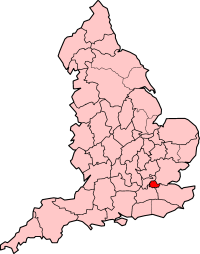Toponymy
The etymology of London is uncertain, but is known to be an ancient name.[1] The concept of East London as a distinct area is a relatively recent innovation. John Strype's map of 1720 describes London as consisting of four parts: The City of London, Westminster, Southwark and "That Part Beyond the Tower".[2] From the late 19th century the term East End of London was used to describe areas immediately adjacent to the City[1] in the Tower division of Middlesex. Charles Booth in 1889 defined East London as the County of London between the City and the River Lea.[3] In 1902 he now considered this area to be the 'true East End' and his attention had been drawn eastward over the Lea into the Borough of West Ham—then outside London in Essex but under the authority of neither—and termed London-over-the-Border by Charles Dickens in 1857. Walter Besant described East London as an area north of the Thames and east of the City that stretched as far as Chingford and Epping Forest,[4] which was similar to the definition used by Robert Sinclair in 1950 that stretched east to include Barking and Dagenham.[5] This broadly matched the Metropolitan Police District east of the city and north of the Thames at that time, and now corresponds to the boroughs of Barking and Dagenham, Hackney, Havering, Newham, Redbridge, Tower Hamlets and Waltham Forest in Greater London.The County of London was a county of England from 1889 to 1965, corresponding to the area known today as Inner London. It was created as part of the general introduction of elected county government in England, by way of the Local Government Act 1888. The Act created an administrative County of London, which included within it

territory the City of London. However, the City of London and the County of London formed separate counties for "non-administrative" purposes.[1] The local authority for the county was the London County Council (LCC), which initially performed only a limited range of functions, but gained further powers during its 76-year existence. The LCC provided very few services within the City of London, where the ancient Corporation monopolised local governance, as it still does.[1] In 1900 the lower-tier civil parishes and district boards were replaced with 28 new metropolitan boroughs. The territory of the county was 74,903 acres (303.12 km2) in 1961. During its existence there was a long-term decline in population as more residents moved into the outer suburbs; there were periodic reviews of the local government structures in the greater London area and several failed attempts to expand the boundaries of the county. In 1965, the London Government Act 1963 replaced the county with the much larger Greater London administrative area.The county occupied an area of just under 75,000 acres (30,351 ha) and lay within the London Basin.[2] It was divided into two parts (north and south) by the River Thames, which was the most significant geographic feature. It bordered Essex to the north east, Kent to the south east, Surrey the south west and Middlesex to the north. The highest point was Hampstead Heath in the north of the county at 440 feet (134 m), which is one of the highest points in London. In 1900 a number of boundary anomalies were abolished. These included the loss of the Alexandra Park exclave to Middlesex, gaining South Hornsey in return, and the transfer of Penge to Kent.